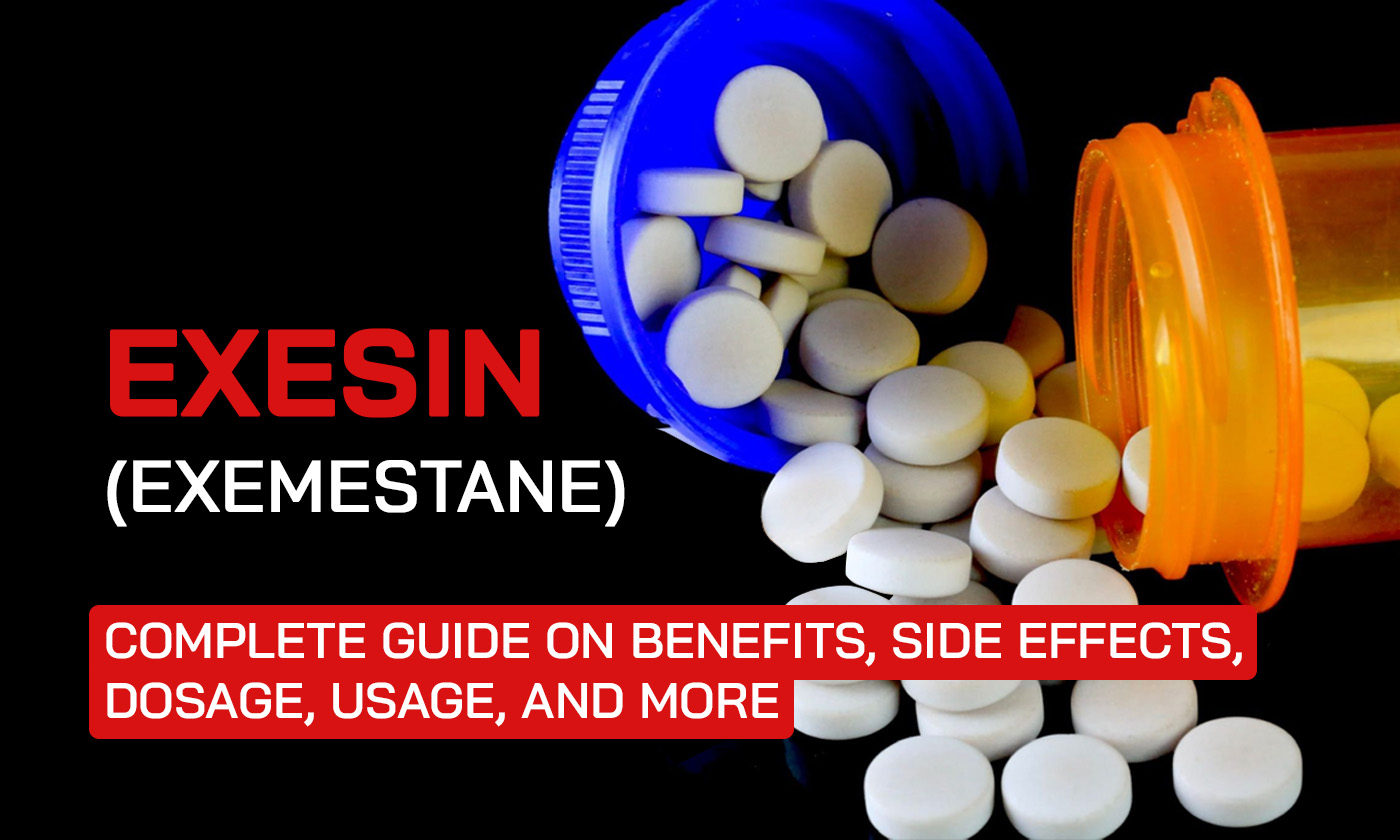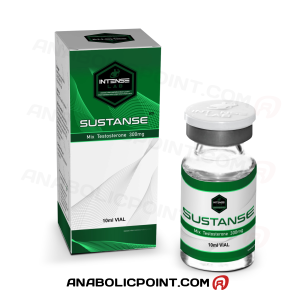Your basket is currently empty!
Exesin (Exemestane): Complete Guide on Benefits, Side Effects, Dosage, Usage, and More

Introduction
Exesin, also known by its generic name Exemestane, is a medication commonly used in the treatment of breast cancer in postmenopausal women. It belongs to a class of drugs known as aromatase inhibitors and works by significantly reducing the levels of estrogen in the body, which can fuel the growth of certain types of breast cancer. Over the years, Exesin (Exemestane) has gained attention not only for its clinical applications in cancer treatment but also in other domains such as hormonal balance and bodybuilding due to its ability to reduce estrogenic side effects.
This article aims to provide a comprehensive overview of Exesin, detailing its mechanisms, benefits, side effects, dosage recommendations, and practical applications. Whether you’re seeking information for medical purposes or considering its use in sports and bodybuilding, this article will cover everything you need to know about Exesin (Exemestane).
What is Exesin (Exemestane)?
Exesin (Exemestane) is a third-generation aromatase inhibitor that is primarily used in the treatment of hormone receptor-positive breast cancer in postmenopausal women. It works by inhibiting the aromatase enzyme, which is responsible for converting androgens (male hormones) into estrogen, the female sex hormone. By lowering estrogen levels in the body, Exemestane helps reduce the growth and spread of estrogen-dependent breast cancer cells.
Exesin was developed to offer a more effective alternative to older medications such as tamoxifen, which blocks estrogen receptors but does not directly reduce estrogen production. As a result, Exemestane is often prescribed to patients who have completed initial breast cancer treatments like surgery or chemotherapy to reduce the risk of cancer recurrence.
In addition to its use in cancer treatment, Exemestane has also found use in fields like bodybuilding and sports performance, where it helps mitigate estrogen-related side effects caused by anabolic steroid use. This dual application makes it a versatile compound in both clinical and non-clinical settings.
History of Exesin (Exemestane)
The history of Exemestane traces back to the late 1990s, when it was developed as part of the search for more effective aromatase inhibitors for treating hormone-receptor-positive breast cancer. Aromatase inhibitors emerged as a significant advancement over older drugs like tamoxifen, which only blocked estrogen’s effects on receptors without lowering estrogen production.
Exemestane was synthesized by the pharmaceutical company Pfizer and was initially marketed under the brand name Aromasin. It was approved by the U.S. Food and Drug Administration (FDA) in 1999 for the treatment of breast cancer in postmenopausal women. Since then, Exemestane has become a mainstay in cancer therapy due to its potent ability to block estrogen production in the body.
Over time, Exemestane gained popularity beyond its medical use, especially in the realm of bodybuilding and performance enhancement, where it became valued for its ability to control gynecomastia (male breast tissue enlargement) and other estrogenic side effects caused by anabolic steroid use.
How Does Exesin (Exemestane) Work Technically?
Exemestane works by specifically inhibiting the aromatase enzyme, which plays a crucial role in the biosynthesis of estrogen. Estrogen is a hormone that is produced primarily in the ovaries but also in peripheral tissues, such as fat tissue and muscles, via the conversion of androgens (testosterone and other male hormones).
In postmenopausal women, the ovaries stop producing estrogen, but aromatase continues to produce small amounts of estrogen in peripheral tissues. This estrogen can promote the growth of certain types of breast cancer, particularly those that are estrogen-receptor-positive. By blocking the action of aromatase, Exemestane reduces estrogen production in the body, making it harder for estrogen-dependent cancer cells to grow and proliferate.
In the world of bodybuilding, Exemestane is used to control the estrogenic side effects that arise from the use of anabolic steroids, which can increase estrogen levels in the body. Gynecomastia (the development of male breast tissue) is one of the most common estrogen-related issues that bodybuilders face. By lowering estrogen levels, Exemestane can help reduce this side effect, along with others like water retention and fat gain, ensuring that users maintain a more androgenic balance.
Benefits of Exesin (Exemestane)
Exemestane offers a variety of benefits, especially in the context of cancer treatment and hormone management. The following are the key benefits:
1. Effective Breast Cancer Treatment
- Exemestane is highly effective in the treatment of hormone-receptor-positive breast cancer in postmenopausal women. By inhibiting the aromatase enzyme, it significantly reduces estrogen production, making it difficult for estrogen-dependent cancer cells to grow.
2. Prevention of Cancer Recurrence
- After surgery, chemotherapy, or radiation therapy, Exemestane is often prescribed as part of an adjuvant treatment to reduce the risk of breast cancer recurrence. By continuously lowering estrogen levels, Exemestane minimizes the chances of the cancer returning.
3. Reduction of Estrogenic Side Effects in Bodybuilding
- Bodybuilders often use Exemestane during anabolic steroid cycles to control estrogenic side effects such as gynecomastia (male breast tissue growth), water retention, and fat gain. By lowering estrogen levels, Exemestane helps maintain a more lean and defined physique.
4. Improved Muscle Definition and Vascularity
- By reducing estrogen-related water retention, Exemestane can help bodybuilders achieve a more defined and vascular appearance, particularly during cutting cycles when fat loss and muscle definition are prioritized.
5. Effective Management of Hormonal Imbalances in Men
- In addition to its use in women, Exemestane is sometimes used off-label in men to help manage hormonal imbalances such as low testosterone. By reducing estrogen levels, it can increase testosterone production, which may help improve muscle mass, libido, and overall vitality.
Side Effects of Exesin (Exemestane)
Like any medication, Exemestane can cause a range of side effects. While many of these are mild and temporary, others can be more serious and require medical attention. Here are the most common side effects of Exemestane:
1. Hot Flashes
- A common side effect of aromatase inhibitors like Exemestane is hot flashes, which may cause discomfort or sweating. These typically subside after a few weeks of use.
2. Joint Pain and Stiffness
- Some users report experiencing joint pain or stiffness, which can affect their daily activities or exercise routines.
3. Osteoporosis and Bone Fractures
- Long-term use of Exemestane may lead to decreased bone mineral density, increasing the risk of osteoporosis and bone fractures.
4. Fatigue and Weakness
- Fatigue is a common side effect, especially in cancer patients undergoing long-term treatment. Some users may experience weakness or a lack of energy, which can interfere with daily tasks.
5. Nausea and Vomiting
- Some individuals may experience gastrointestinal side effects such as nausea or vomiting, which can cause discomfort and affect appetite.
6. Increased Cholesterol Levels
- Long-term use of Exemestane may result in increased cholesterol levels, which can raise the risk of cardiovascular issues.
7. Mood Swings and Depression
- Hormonal changes due to Exemestane use can lead to mood swings, irritability, or even depression in some users.
8. Liver Dysfunction
- Although rare, liver toxicity or elevated liver enzymes can occur, particularly with prolonged use of Exemestane.
Dosage and How to Use Exesin (Exemestane)
The recommended dosage of Exemestane depends on the specific condition being treated:
1. For Breast Cancer Treatment
- The typical dose for breast cancer treatment is 25 mg once a day, taken orally, with or without food. This is usually continued for 5 years or longer, depending on the patient’s response and the doctor’s recommendations.
2. For Bodybuilding (Off-Label Use)
- In bodybuilding, Exemestane is often used at a dose of 12.5 mg to 25 mg per day, depending on the individual’s steroid cycle and estrogenic side effects. However, the use of Exemestane for bodybuilding purposes should be done under professional guidance to avoid complications.
3. For Hormonal Imbalances in Men
- Exemestane may be used at a dose of 12.5 mg every other day for men seeking to lower estrogen levels and balance their hormones. However, consultation with a healthcare provider is essential.
10 Most Common Questions About Exesin (Exemestane)
1. What is Exesin used for?
- Exesin is primarily used to treat breast cancer in postmenopausal women. It reduces estrogen production, which is essential for the growth of hormone receptor-positive breast cancer.
2. Can Exesin help with gynecomastia?
- Yes, Exesin is used in bodybuilding to control gynecomastia, a common estrogenic side effect of anabolic steroid use.
3. Is Exesin effective for weight loss?
- Exesin does not directly promote fat loss but may help reduce water retention and bloating, which can improve muscle definition and appearance.
4. Are there any serious side effects of Exesin?
- Serious side effects may include bone loss, liver toxicity, and cardiovascular issues. Regular monitoring by a healthcare professional is recommended.
5. How long should I take Exesin for cancer treatment?
- The typical course for cancer treatment is 5 years, but this may vary depending on individual circumstances and doctor recommendations.
6. Can Exesin increase testosterone levels in men?
- Yes, Exesin can help increase testosterone production by reducing estrogen levels in men with hormonal imbalances.
7. Can Exesin cause weight gain?
- Weight gain is not a typical side effect, but some users may experience changes in metabolism or appetite.
8. Is Exesin safe for long-term use?
- While Exesin is safe for long-term use in cancer treatment, its long-term use should be carefully monitored due to potential side effects like osteoporosis and joint pain.
9. Can I take Exesin without food?
- Yes, Exesin can be taken with or without food, but it’s important to follow your doctor’s instructions regarding dosage.
10. Can I combine Exesin with other medications?
- Exesin may interact with other medications, so always consult your doctor before combining it with other drugs.
Conclusion
Exesin (Exemestane) is a powerful aromatase inhibitor with significant applications in breast cancer treatment, bodybuilding, and hormone regulation. Whether used in oncology to prevent cancer recurrence or in sports medicine to manage estrogenic side effects, Exemestane offers a variety of benefits. However, it also comes with a potential for side effects, especially when used long-term. Always consult with a healthcare provider before using Exesin for medical or non-medical purposes to ensure its safety and effectiveness in your particular case.












